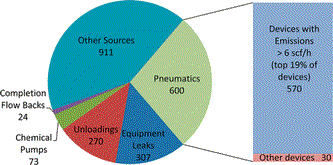A team of researchers from the Cockrell School of Engineering at the University of Texas at Austin and environmental testing firm URS reports that a small subset of natural gas wells are responsible for the majority of methane emissions from two major sources – liquid unloadings and pneumatic controller equipment – at natural gas production sites.
With natural gas production in the United States expected to continue to increase during the next few decades, there is a need for a better understanding of methane emissions during natural gas production. The study team believes this research, published Dec. 9 in Environmental Science & Technology, will help to provide a clearer picture of methane emissions from natural gas production sites.
The UT Austin-led field study closely examined two major sources of methane emissions – liquid unloadings and pneumatic controller equipment – at well pad sites across the United States. Researchers found that 19 percent of the pneumatic devices accounted for 95 percent of the emissions from pneumatic devices, and 20 percent of the wells with unloading emissions that vent to the atmosphere accounted for 65 percent to 83 percent of those emissions.
“To put this in perspective, over the past several decades, 10 percent of the cars on the road have been responsible for the majority of automotive exhaust pollution,” said David Allen, chemical engineering professor at the Cockrell School and principal investigator for the study.
“Similarly, a small group of sources within these two categories are responsible for the vast majority of pneumatic and unloading emissions at natural gas production sites.”
Additionally, for pneumatic devices, the study confirmed regional differences in methane emissions first reported by the study team in 2013. The researchers found that methane emissions from pneumatic devices were highest in the Gulf Coast and lowest in the Rocky Mountains.
The study is the second phase of the team’s 2013 study, which included some of the first measurements for methane emissions taken directly at hydraulically fractured well sites. Both phases of the study involved a partnership between the Environmental Defense Fund, participating energy companies, an independent Scientific Advisory Panel and the UT Austin study team.
The unprecedented access to natural gas production facilities and equipment allowed researchers to acquire direct measurements of methane emissions.
The complete report can be found here.
Reprinted from the University of Texas at Austin Center for Energy and Environmental Resources .



